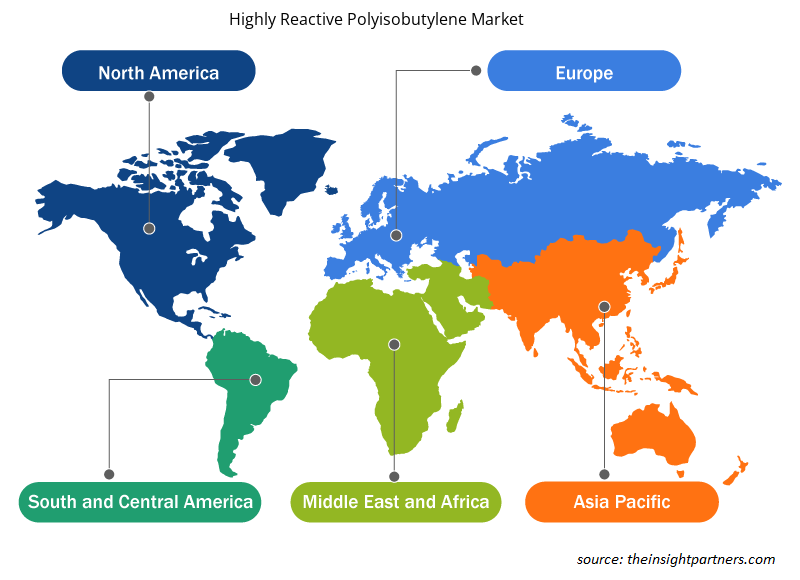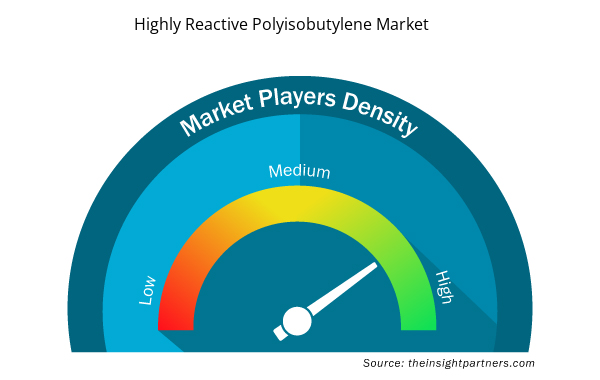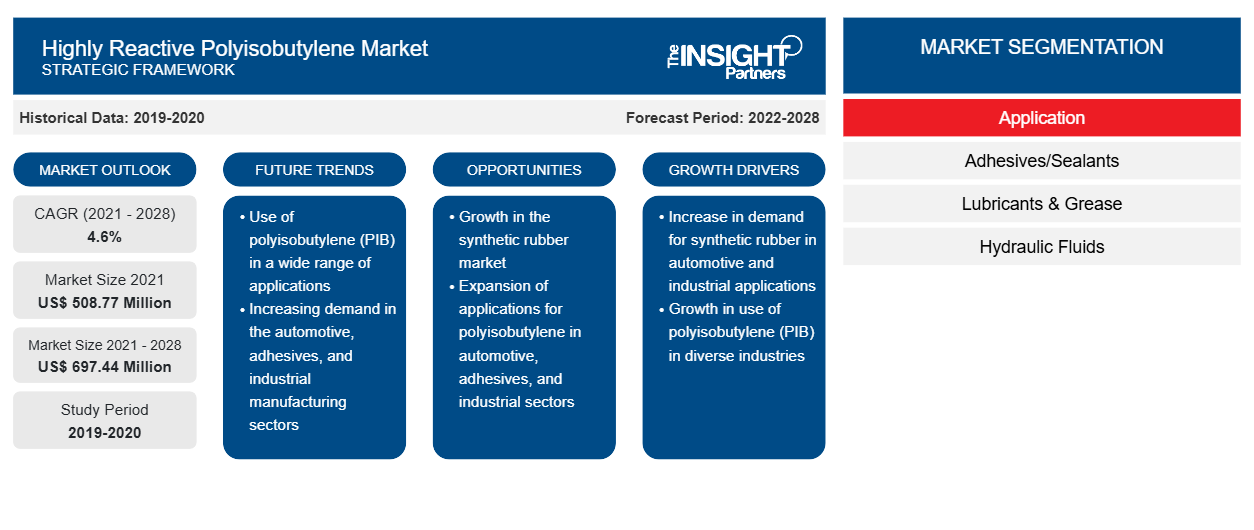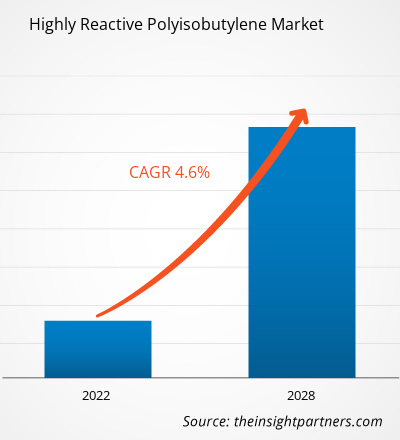고반응성 폴리이소부틸렌 시장 규모는 2021년 5억 877만 달러에서 2028년 6억 9,744만 달러로 성장할 것으로 전망되며, 2021년에서 2028년까지 연평균 성장률 4.6%로 성장할 것으로 예상됩니다.
고반응성 폴리이소부틸렌 ( HR-PIB )은 엔진 오일이나 연료 세정제 용 분산제 와 같은 고성능 연료 및 윤활제 첨가제 생산에 사용되는 중요한 중간체입니다 . 고성능 윤활제 첨가제는 연료 효율이 더 높은 엔진 설계를 가능하게 합니다.
2020년 아시아 태평양 지역은 고반응성 폴리이소부틸렌 시장 에서 가장 큰 매출 점유율을 차지했습니다 . 윤활유 및 그리스 부문은 아시아 태평양 지역에서 HR-PIB 의 가장 큰 소비자입니다 . 이 지역의 자동차 부문의 확산은 유압 유체 및 윤활유에 대한 수요를 증가시켜 HR-PIB 에 대한 필요성을 촉진하고 있습니다. 또한 아시아 태평양 지역의 산업화 및 건설 증가는 관련 제조 시설의 기계 및 장비에 대한 수요를 촉진하고 있습니다.
귀하의 요구 사항에 맞게 이 보고서를 사용자 정의하세요
이 보고서의 일부 또는 국가 수준 분석, Excel 데이터 팩을 포함하여 모든 보고서에 대한 사용자 정의를 무료로 받을 수 있으며 신생 기업 및 대학을 위한 훌륭한 혜택과 할인 혜택을 이용할 수 있습니다.
- 이 보고서의 주요 시장 동향을 알아보세요.이 무료 샘플에는 시장 동향부터 추정 및 예측까지 다양한 데이터 분석이 포함됩니다.
고반응성 폴리이소부틸렌 시장 에 대한 COVID-19 팬데믹의 영향
2020년에는 국가 및 국제적 경계가 폐쇄되어 공급망이 중단되어 다양한 산업이 운영을 늦춰야 했고, 이로 인해 HR-PIB 에 대한 수요가 감소 했습니다. 팬데믹으로 인해 다양한 국가의 정부 당국이 작업장 인원과 운송 수단에 제한을 가해 제조 공정이 중단되었고, 이로 인해 직원들이 작업장으로 출퇴근하는 데 어려움을 겪었습니다. HR-PIB는 고성능 연료 및 윤활유 첨가제 제조에 주요 응용 분야가 있습니다. 다양한 산업의 연료 수요 감소로 인해 연료 첨가제 소비가 저해되어 결국 HR-PIB 판매가 저해되었습니다 . 그러나 경제가 2021년에 운영을 재개하면서 HR-PIB 에 대한 수요 도 점차 증가하기 시작했습니다.
시장 통찰력
고성능 연료 및 윤활유 첨가제 생산에서 HR-PIB 사용 증가
HR-PIB 는 고성능 연료 및 윤활유 첨가제 생산에 적용되는 중요한 중간체입니다 . 반응성이 매우 높아 첨가제 생산 시 기존 폴리이소부틸렌 보다 선호됩니다. 윤활유 첨가제의 주요 기능은 다양한 작동 조건에서 기본 스톡의 특성을 개선하는 것입니다. 또한 고성능 윤활유 첨가제는 연료 효율이 더 높은 엔진 설계를 지원합니다. 분산제 는 중요한 표면에 슬러지, 바니시 및 기타 침전물이 형성되는 것을 방지하는 윤활유 첨가제입니다. 자동차 엔진 오일용 분산제 의 산업적 합성에서 HR-PIB 에 대한 수요가 증가하고 있습니다 . 미국, 유럽 및 아시아 태평양 지역에 강력한 첨가제 제조 기반이 있어 HR-PIB 의 주요 소비자가 되었습니다. 따라서 고성능 연료 및 윤활유 첨가제 제조에 HR-PIB 를 사용하는 것이 증가함에 따라 시장 성장이 촉진됩니다.
애플리케이션 인사이트
응용 프로그램을 기준으로, 고반응성 폴리 이소부틸렌 시장은 접착제/실란트, 윤활제 및 그리스, 유압 유체, 금속 가공 유체 등으로 세분화되었습니다. 윤활제 및 그리스 부문은 2020년에 가장 큰 시장 점유율을 차지했습니다. 엔진 오일, 변속기 오일, 기어 오일, 그리스, 압축기 오일과 같은 윤활제는 자동차, 항공기, 선박 및 기계 산업에서 많이 소비됩니다. HR-PIB는 윤활제의 전반적인 성능을 향상시키는 데 도움이 됩니다.
TPC Group; RB PRODUCTS INC.; BASF PETRONAS Chemicals Sdn . Bhd ; Shandong Hongrui New Material Technology Co., Ltd; Daelim Co., Ltd.; Chevron Corporation; The Lubrizol Corporation; KEMAT Polybutenes ; Weifang Binhai Petro-chem Co., Ltd.; Nelson Brothers Incorporated는 고반응성 폴리 이소부틸렌 시장 의 주요 시장 참여자입니다 . 고반응성 폴리 이소부틸렌 시장에서 활동하는 참여자는 고객 요구 사항을 충족하기 위해 고품질의 혁신적인 제품 개발에 집중하고 있습니다.
고반응성 폴리이소부틸렌 시장 지역 통찰력
Insight Partners의 분석가들은 예측 기간 동안 고반응성 폴리이소부틸렌 시장에 영향을 미치는 지역적 추세와 요인을 철저히 설명했습니다. 이 섹션에서는 북미, 유럽, 아시아 태평양, 중동 및 아프리카, 남미 및 중미의 고반응성 폴리이소부틸렌 시장 세그먼트와 지리에 대해서도 설명합니다.

- 고반응성 폴리이소부틸렌 시장에 대한 지역별 특정 데이터 얻기
고반응성 폴리이소부틸렌 시장 보고서 범위
| 보고서 속성 | 세부 |
|---|---|
| 2021년 시장 규모 | 5억 877만 달러 |
| 2028년까지 시장 규모 | 6억 9,744만 달러 |
| 글로벌 CAGR (2021-2028) | 4.6% |
| 역사적 데이터 | 2019-2020 |
| 예측 기간 | 2022-2028 |
| 다루는 세그먼트 | 응용 프로그램으로
|
| 포함된 지역 및 국가 | 북아메리카
|
| 시장 선도 기업 및 주요 회사 프로필 |
|
고반응성 폴리이소부틸렌 시장 참여자 밀도: 비즈니스 역학에 미치는 영향 이해
고반응성 폴리이소부틸렌 시장은 소비자 선호도의 변화, 기술 발전, 제품의 이점에 대한 인식 증가와 같은 요인으로 인해 최종 사용자 수요가 증가함에 따라 빠르게 성장하고 있습니다. 수요가 증가함에 따라 기업은 제품을 확장하고, 소비자의 요구를 충족하기 위해 혁신하고, 새로운 트렌드를 활용하여 시장 성장을 더욱 촉진하고 있습니다.
시장 참여자 밀도는 특정 시장이나 산업 내에서 운영되는 회사나 기업의 분포를 말합니다. 주어진 시장 공간에 얼마나 많은 경쟁자(시장 참여자)가 존재하는지 그 규모나 전체 시장 가치에 비해 나타냅니다.
고반응성 폴리이소부틸렌 시장에서 운영되는 주요 회사는 다음과 같습니다.
- TPC그룹
- RB 프로덕츠 주식회사
- BASF PETRONAS Chemicals Sdn. Bhd
- 산둥 홍루이 신소재 기술 유한회사
- 대림(주)
면책 조항 : 위에 나열된 회사는 어떤 특별한 순서에 따라 순위가 매겨지지 않았습니다.

- 고반응성 폴리이소부틸렌 시장 주요 주요 업체 개요를 알아보세요
스포트라이트 보고서
- 고반응성 폴리이소부틸렌 산업의 진보적 추세는 플레이어가 효과적인 장기 전략을 개발하는 데 도움이 됩니다.
- 선진국과 개발도상국 시장에서 성장을 보장하기 위해 기업이 채택한 사업 성장 전략
- 2019년부터 2028년까지 고반응성 폴리 이소부틸렌 시장 의 정량적 분석
- HR-PIB 에 대한 글로벌 수요 추산
- 산업에서 운영되는 구매자와 공급자의 효율성을 설명하기 위한 포터의 5가지 힘 분석
- 경쟁 시장 시나리오를 이해하기 위한 최근 개발
- 고반응성 폴리이소부틸렌 시장 성장을 촉진하고 제한하는 시장 동향 및 전망, 요인
- 상업적 이익을 뒷받침하는 시장 전략을 강조하여 의사 결정 프로세스 지원
- 다양한 노드에서의 고반응성 폴리이소부틸렌 시장 규모
- 시장의 세부적인 개요 및 세분화, HR-PIB 산업 역학
- 유망한 성장 기회를 지닌 다양한 지역의 고반응성 폴리 이소부틸렌 시장 규모
고반응성 폴리이소부틸렌 시장
애플리케이션
- 접착제/실란트
- 윤활제 및 그리스
- 유압유
- 금속 가공 유체
- 기타
회사 프로필
- TPC 그룹
- RB 프로덕츠 주식회사
- BASF PETRONAS Chemicals Sdn . Bhd
- 산둥 홍루이 신소재 기술 유한회사
- 대림 (주)
- 쉐브론 코퍼레이션
- 루 브리졸 주식회사
- KEMAT 폴리부텐
- 웨이 팡빈 하이석유화학 유한공사
- 넬슨 브라더스 주식회사
- 역사적 분석(2년), 기준 연도, CAGR을 포함한 예측(7년)
- PEST 및 SWOT 분석
- 시장 규모 가치/양 - 글로벌, 지역, 국가
- 산업 및 경쟁 환경
- Excel 데이터 세트



Report Coverage
Revenue forecast, Company Analysis, Industry landscape, Growth factors, and Trends

Segment Covered
This text is related
to segments covered.

Regional Scope
North America, Europe, Asia Pacific, Middle East & Africa, South & Central America

Country Scope
This text is related
to country scope.
자주 묻는 질문
Production techniques and catalysts used to synthesize HR-PIB have become an important subject for research and development activities in the last few decades. Research and development activities are mostly focusing on new polymerization techniques with greater potential advantages than traditional techniques. Various research groups are also actively investigating new catalysts for synthesizing highly reactive polyisobutylene; this further underlines the demand for different polymerization techniques than the existing ones. In addition, HR-PIB is gaining significant popularity in different downstream functionalization reactions due to its greater reactivity than its conventional counterparts. These factors are likely to lead to new future trends in the highly reactive polyisobutylene market.
Players operating in the highly reactive polyisobutylene market are increasingly focusing on ramping up their production capacities to meet future customer demands by making significant investments. They are implementing plans to set up additional capacities of highly reactive polyisobutylene. In 2019, Saudi Aramco and Total announced an agreement with Daelim, a South Korean petrochemical company, to build a new polyisobutylene facility. As per the Memorandum of Understanding (MoU) between these companies, Daelim is planning to build a new state-of-the-art PIB plant with a capacity of 80,000 tons. The new plant is expected to come on-stream in 2024. This specialty chemical project will be using Daelim’s PIB proprietary technology to produce a wide range of products, from conventional PIB (CPIB) to HR-PIB, in a single plant. Hence, the growing focus of market players to escalate their capacities of HR-PIB production will offer huge growth opportunities to the market players in the coming years.
Increasing use of highly reactive polyisobutylene in high-performance fuel and lubricant additive production and proliferation of the automotive sector are the key factors driving the highly reactive polyisobutylene market during the forecast period. Highly reactive polyisobutylene is an important intermediate that finds application in the production of high-performance fuel and lubricant additives, such as fuel detergents or dispersants for engine oils. Due to its highly reactive nature, highly reactive polyisobutylene is preferred over conventional polyisobutylene in additive production. The demand for highly reactive polyisobutylene is growing in the industrial synthesis of dispersants for automotive engine oils. Moreover, highly reactive polyisobutylene finds applications in the production of fuel and lubricant additives, sealants, adhesives, and greases, among others, the flourishment of the automotive sector, in turn, creates a high demand for the same, thereby boosting the market growth.
Based on application, the lubricant and grease segment led the global highly reactive polyisobutylene market in 2020. Lubricants such as engine oils, transmission oils, gear oils, greases, and compressor oils are highly consumed in automotive, aircraft, marine, and machinery industries. highly reactive polyisobutylene is used as an intermediate for lubricant additive manufacturing. It helps to enhance the overall performance of lubricant and grease which is propelling the segment growth.
The major players operating in the global highly reactive polyisobutylene market are TPC Group; RB PRODUCTS INC.; BASF PETRONAS Chemicals Sdn. Bhd; Shandong Hongrui New Material Technology Co., Ltd; Daelim Co., Ltd.; Chevron Corporation; The Lubrizol Corporation; KEMAT Polybutenes; Weifang Binhai Petro-chem Co., Ltd.; and Nelson Brothers Incorporated.
During the forecast period, Asia-Pacific is anticipated to account for the largest share of the global highly reactive polyisobutylene market. Asia-Pacific region comprises several developed and developing economies, including China, India, Japan, South Korea, among others. The region is experiencing significant growth in automotive, which is boosting the demand for hydraulic fluid and lubricants which directly boosts demand for highly reactive polyisobutylene. Further, the increase in industrialization and construction in the region is driving the demand of machineries and equipment for manufacturing facilities, hydraulic fluids and sealants are widely used in these industries.
Trends and growth analysis reports related to Chemicals and Materials : READ MORE..
The List of Companies - Highly Reactive Polyisobutylene Market
- TPC Group
- RB PRODUCTS INC.
- BASF PETRONAS Chemicals Sdn. Bhd
- Shandong Hongrui New Material Technology Co., Ltd
- Daelim Co., Ltd.
- Chevron Corporation
- The Lubrizol Corporation
- KEMAT Polybutenes
- Weifang Binhai Petro-chem Co., Ltd.
- Nelson Brothers Incorporated
The Insight Partners performs research in 4 major stages: Data Collection & Secondary Research, Primary Research, Data Analysis and Data Triangulation & Final Review.
- Data Collection and Secondary Research:
As a market research and consulting firm operating from a decade, we have published and advised several client across the globe. First step for any study will start with an assessment of currently available data and insights from existing reports. Further, historical and current market information is collected from Investor Presentations, Annual Reports, SEC Filings, etc., and other information related to company’s performance and market positioning are gathered from Paid Databases (Factiva, Hoovers, and Reuters) and various other publications available in public domain.
Several associations trade associates, technical forums, institutes, societies and organization are accessed to gain technical as well as market related insights through their publications such as research papers, blogs and press releases related to the studies are referred to get cues about the market. Further, white papers, journals, magazines, and other news articles published in last 3 years are scrutinized and analyzed to understand the current market trends.
- Primary Research:
The primarily interview analysis comprise of data obtained from industry participants interview and answers to survey questions gathered by in-house primary team.
For primary research, interviews are conducted with industry experts/CEOs/Marketing Managers/VPs/Subject Matter Experts from both demand and supply side to get a 360-degree view of the market. The primary team conducts several interviews based on the complexity of the markets to understand the various market trends and dynamics which makes research more credible and precise.
A typical research interview fulfils the following functions:
- Provides first-hand information on the market size, market trends, growth trends, competitive landscape, and outlook
- Validates and strengthens in-house secondary research findings
- Develops the analysis team’s expertise and market understanding
Primary research involves email interactions and telephone interviews for each market, category, segment, and sub-segment across geographies. The participants who typically take part in such a process include, but are not limited to:
- Industry participants: VPs, business development managers, market intelligence managers and national sales managers
- Outside experts: Valuation experts, research analysts and key opinion leaders specializing in the electronics and semiconductor industry.
Below is the breakup of our primary respondents by company, designation, and region:

Once we receive the confirmation from primary research sources or primary respondents, we finalize the base year market estimation and forecast the data as per the macroeconomic and microeconomic factors assessed during data collection.
- Data Analysis:
Once data is validated through both secondary as well as primary respondents, we finalize the market estimations by hypothesis formulation and factor analysis at regional and country level.
- Macro-Economic Factor Analysis:
We analyse macroeconomic indicators such the gross domestic product (GDP), increase in the demand for goods and services across industries, technological advancement, regional economic growth, governmental policies, the influence of COVID-19, PEST analysis, and other aspects. This analysis aids in setting benchmarks for various nations/regions and approximating market splits. Additionally, the general trend of the aforementioned components aid in determining the market's development possibilities.
- Country Level Data:
Various factors that are especially aligned to the country are taken into account to determine the market size for a certain area and country, including the presence of vendors, such as headquarters and offices, the country's GDP, demand patterns, and industry growth. To comprehend the market dynamics for the nation, a number of growth variables, inhibitors, application areas, and current market trends are researched. The aforementioned elements aid in determining the country's overall market's growth potential.
- Company Profile:
The “Table of Contents” is formulated by listing and analyzing more than 25 - 30 companies operating in the market ecosystem across geographies. However, we profile only 10 companies as a standard practice in our syndicate reports. These 10 companies comprise leading, emerging, and regional players. Nonetheless, our analysis is not restricted to the 10 listed companies, we also analyze other companies present in the market to develop a holistic view and understand the prevailing trends. The “Company Profiles” section in the report covers key facts, business description, products & services, financial information, SWOT analysis, and key developments. The financial information presented is extracted from the annual reports and official documents of the publicly listed companies. Upon collecting the information for the sections of respective companies, we verify them via various primary sources and then compile the data in respective company profiles. The company level information helps us in deriving the base number as well as in forecasting the market size.
- Developing Base Number:
Aggregation of sales statistics (2020-2022) and macro-economic factor, and other secondary and primary research insights are utilized to arrive at base number and related market shares for 2022. The data gaps are identified in this step and relevant market data is analyzed, collected from paid primary interviews or databases. On finalizing the base year market size, forecasts are developed on the basis of macro-economic, industry and market growth factors and company level analysis.
- Data Triangulation and Final Review:
The market findings and base year market size calculations are validated from supply as well as demand side. Demand side validations are based on macro-economic factor analysis and benchmarks for respective regions and countries. In case of supply side validations, revenues of major companies are estimated (in case not available) based on industry benchmark, approximate number of employees, product portfolio, and primary interviews revenues are gathered. Further revenue from target product/service segment is assessed to avoid overshooting of market statistics. In case of heavy deviations between supply and demand side values, all thes steps are repeated to achieve synchronization.
We follow an iterative model, wherein we share our research findings with Subject Matter Experts (SME’s) and Key Opinion Leaders (KOLs) until consensus view of the market is not formulated – this model negates any drastic deviation in the opinions of experts. Only validated and universally acceptable research findings are quoted in our reports.
We have important check points that we use to validate our research findings – which we call – data triangulation, where we validate the information, we generate from secondary sources with primary interviews and then we re-validate with our internal data bases and Subject matter experts. This comprehensive model enables us to deliver high quality, reliable data in shortest possible time.


 이 보고서에 대한 무료 샘플을 받으세요
이 보고서에 대한 무료 샘플을 받으세요